Indigenous Community Programs: Ethical Considerations Report
VerifiedAdded on 2023/06/11
|12
|3456
|187
Report
AI Summary
This report examines community-based programs serving Indigenous Australians, focusing on the Bungree Aboriginal Association and the roles, skills, and knowledge required by community youth workers. It emphasizes the importance of cultural competence, including cultural awareness, communication, and overcoming bias. The report also discusses the ethical codes of practice for community workers, highlighting the principles of respecting clients' rights, ensuring social inclusion, and protecting against discrimination. Furthermore, it addresses ethical dilemmas that may arise, such as conflicts between cultural traditions and health practices, and underscores the need for critical analysis and problem-solving skills. The goal is to improve the quality of life for Aboriginal and Torres Strait Islander people by providing effective and culturally sensitive services.
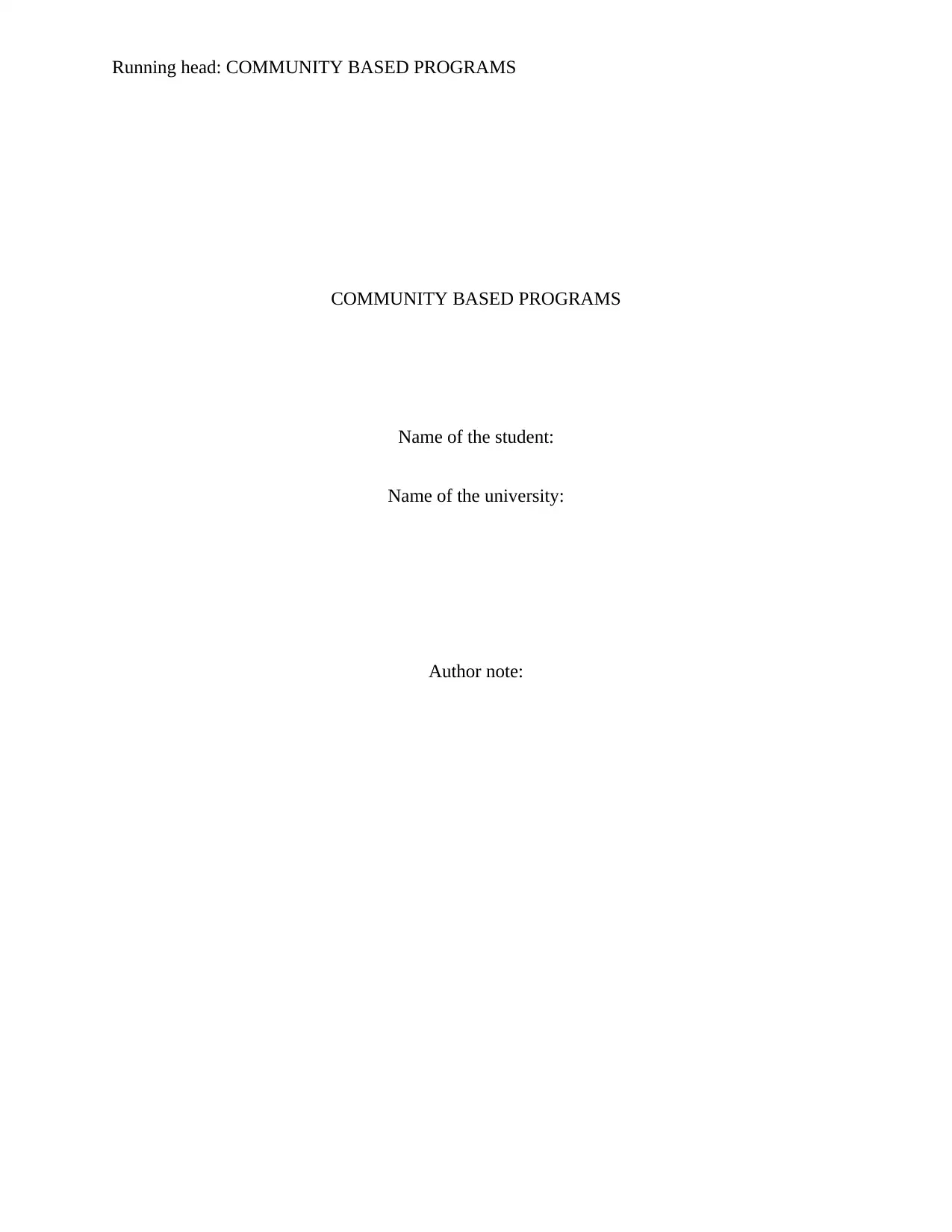
Running head: COMMUNITY BASED PROGRAMS
COMMUNITY BASED PROGRAMS
Name of the student:
Name of the university:
Author note:
COMMUNITY BASED PROGRAMS
Name of the student:
Name of the university:
Author note:
Paraphrase This Document
Need a fresh take? Get an instant paraphrase of this document with our AI Paraphraser
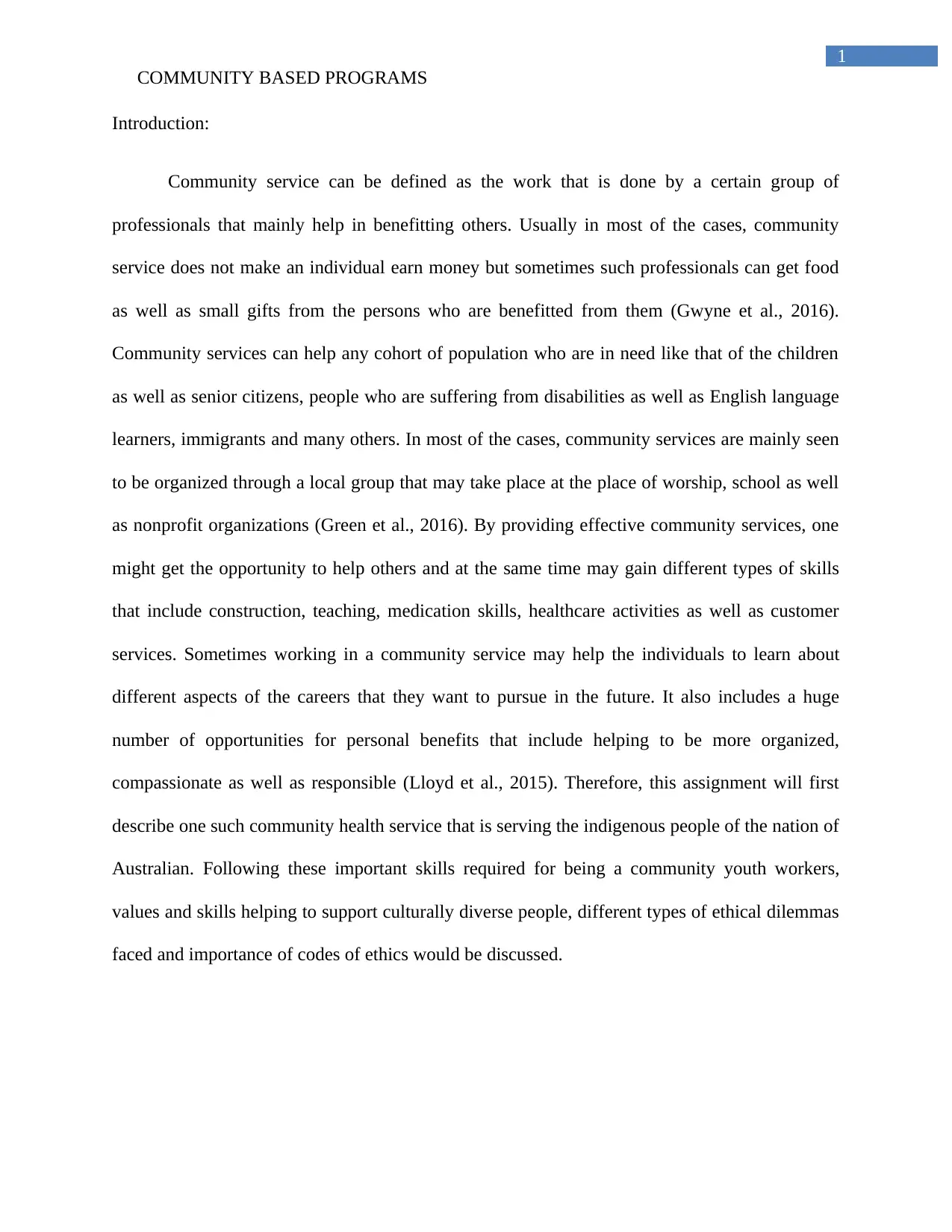
1
COMMUNITY BASED PROGRAMS
Introduction:
Community service can be defined as the work that is done by a certain group of
professionals that mainly help in benefitting others. Usually in most of the cases, community
service does not make an individual earn money but sometimes such professionals can get food
as well as small gifts from the persons who are benefitted from them (Gwyne et al., 2016).
Community services can help any cohort of population who are in need like that of the children
as well as senior citizens, people who are suffering from disabilities as well as English language
learners, immigrants and many others. In most of the cases, community services are mainly seen
to be organized through a local group that may take place at the place of worship, school as well
as nonprofit organizations (Green et al., 2016). By providing effective community services, one
might get the opportunity to help others and at the same time may gain different types of skills
that include construction, teaching, medication skills, healthcare activities as well as customer
services. Sometimes working in a community service may help the individuals to learn about
different aspects of the careers that they want to pursue in the future. It also includes a huge
number of opportunities for personal benefits that include helping to be more organized,
compassionate as well as responsible (Lloyd et al., 2015). Therefore, this assignment will first
describe one such community health service that is serving the indigenous people of the nation of
Australian. Following these important skills required for being a community youth workers,
values and skills helping to support culturally diverse people, different types of ethical dilemmas
faced and importance of codes of ethics would be discussed.
COMMUNITY BASED PROGRAMS
Introduction:
Community service can be defined as the work that is done by a certain group of
professionals that mainly help in benefitting others. Usually in most of the cases, community
service does not make an individual earn money but sometimes such professionals can get food
as well as small gifts from the persons who are benefitted from them (Gwyne et al., 2016).
Community services can help any cohort of population who are in need like that of the children
as well as senior citizens, people who are suffering from disabilities as well as English language
learners, immigrants and many others. In most of the cases, community services are mainly seen
to be organized through a local group that may take place at the place of worship, school as well
as nonprofit organizations (Green et al., 2016). By providing effective community services, one
might get the opportunity to help others and at the same time may gain different types of skills
that include construction, teaching, medication skills, healthcare activities as well as customer
services. Sometimes working in a community service may help the individuals to learn about
different aspects of the careers that they want to pursue in the future. It also includes a huge
number of opportunities for personal benefits that include helping to be more organized,
compassionate as well as responsible (Lloyd et al., 2015). Therefore, this assignment will first
describe one such community health service that is serving the indigenous people of the nation of
Australian. Following these important skills required for being a community youth workers,
values and skills helping to support culturally diverse people, different types of ethical dilemmas
faced and importance of codes of ethics would be discussed.
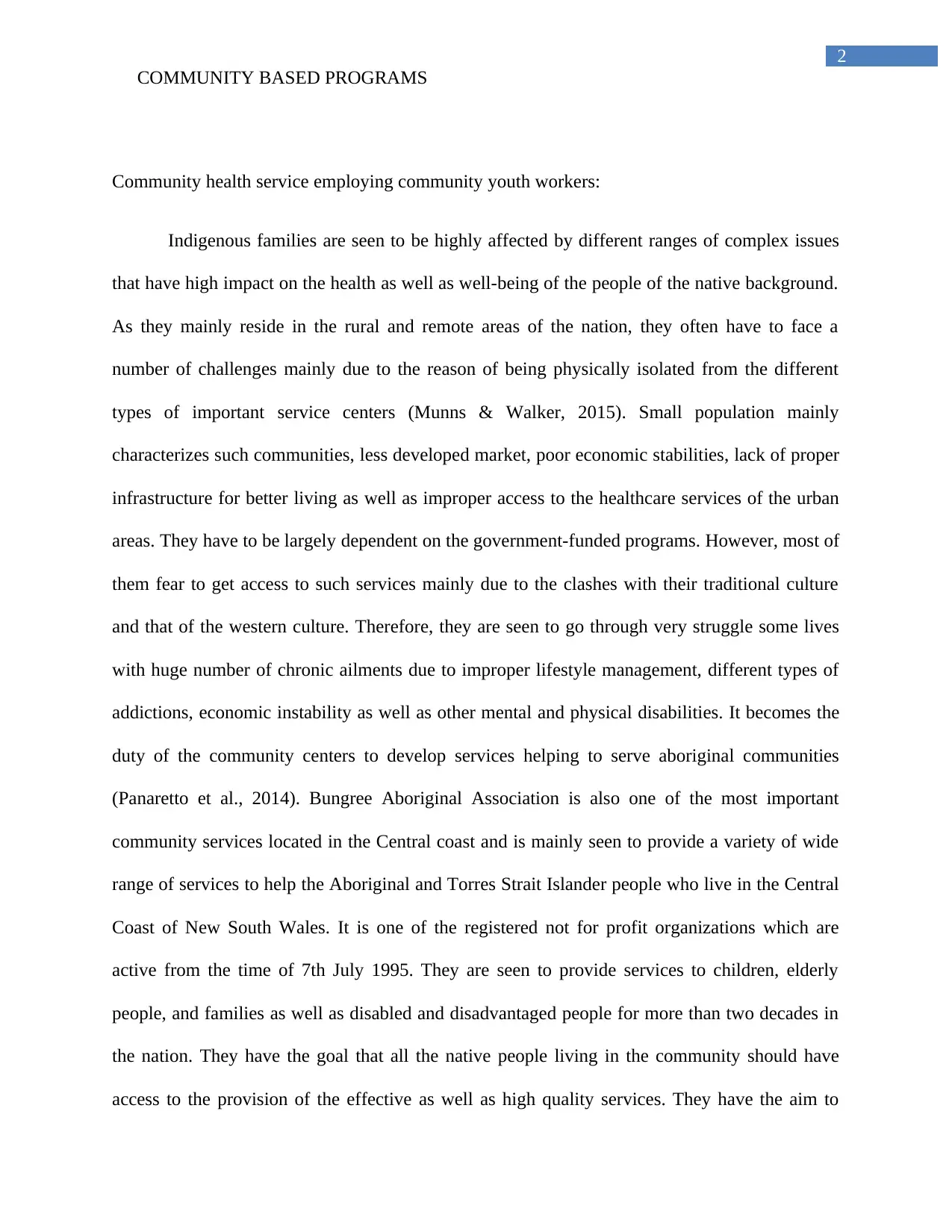
2
COMMUNITY BASED PROGRAMS
Community health service employing community youth workers:
Indigenous families are seen to be highly affected by different ranges of complex issues
that have high impact on the health as well as well-being of the people of the native background.
As they mainly reside in the rural and remote areas of the nation, they often have to face a
number of challenges mainly due to the reason of being physically isolated from the different
types of important service centers (Munns & Walker, 2015). Small population mainly
characterizes such communities, less developed market, poor economic stabilities, lack of proper
infrastructure for better living as well as improper access to the healthcare services of the urban
areas. They have to be largely dependent on the government-funded programs. However, most of
them fear to get access to such services mainly due to the clashes with their traditional culture
and that of the western culture. Therefore, they are seen to go through very struggle some lives
with huge number of chronic ailments due to improper lifestyle management, different types of
addictions, economic instability as well as other mental and physical disabilities. It becomes the
duty of the community centers to develop services helping to serve aboriginal communities
(Panaretto et al., 2014). Bungree Aboriginal Association is also one of the most important
community services located in the Central coast and is mainly seen to provide a variety of wide
range of services to help the Aboriginal and Torres Strait Islander people who live in the Central
Coast of New South Wales. It is one of the registered not for profit organizations which are
active from the time of 7th July 1995. They are seen to provide services to children, elderly
people, and families as well as disabled and disadvantaged people for more than two decades in
the nation. They have the goal that all the native people living in the community should have
access to the provision of the effective as well as high quality services. They have the aim to
COMMUNITY BASED PROGRAMS
Community health service employing community youth workers:
Indigenous families are seen to be highly affected by different ranges of complex issues
that have high impact on the health as well as well-being of the people of the native background.
As they mainly reside in the rural and remote areas of the nation, they often have to face a
number of challenges mainly due to the reason of being physically isolated from the different
types of important service centers (Munns & Walker, 2015). Small population mainly
characterizes such communities, less developed market, poor economic stabilities, lack of proper
infrastructure for better living as well as improper access to the healthcare services of the urban
areas. They have to be largely dependent on the government-funded programs. However, most of
them fear to get access to such services mainly due to the clashes with their traditional culture
and that of the western culture. Therefore, they are seen to go through very struggle some lives
with huge number of chronic ailments due to improper lifestyle management, different types of
addictions, economic instability as well as other mental and physical disabilities. It becomes the
duty of the community centers to develop services helping to serve aboriginal communities
(Panaretto et al., 2014). Bungree Aboriginal Association is also one of the most important
community services located in the Central coast and is mainly seen to provide a variety of wide
range of services to help the Aboriginal and Torres Strait Islander people who live in the Central
Coast of New South Wales. It is one of the registered not for profit organizations which are
active from the time of 7th July 1995. They are seen to provide services to children, elderly
people, and families as well as disabled and disadvantaged people for more than two decades in
the nation. They have the goal that all the native people living in the community should have
access to the provision of the effective as well as high quality services. They have the aim to
⊘ This is a preview!⊘
Do you want full access?
Subscribe today to unlock all pages.

Trusted by 1+ million students worldwide
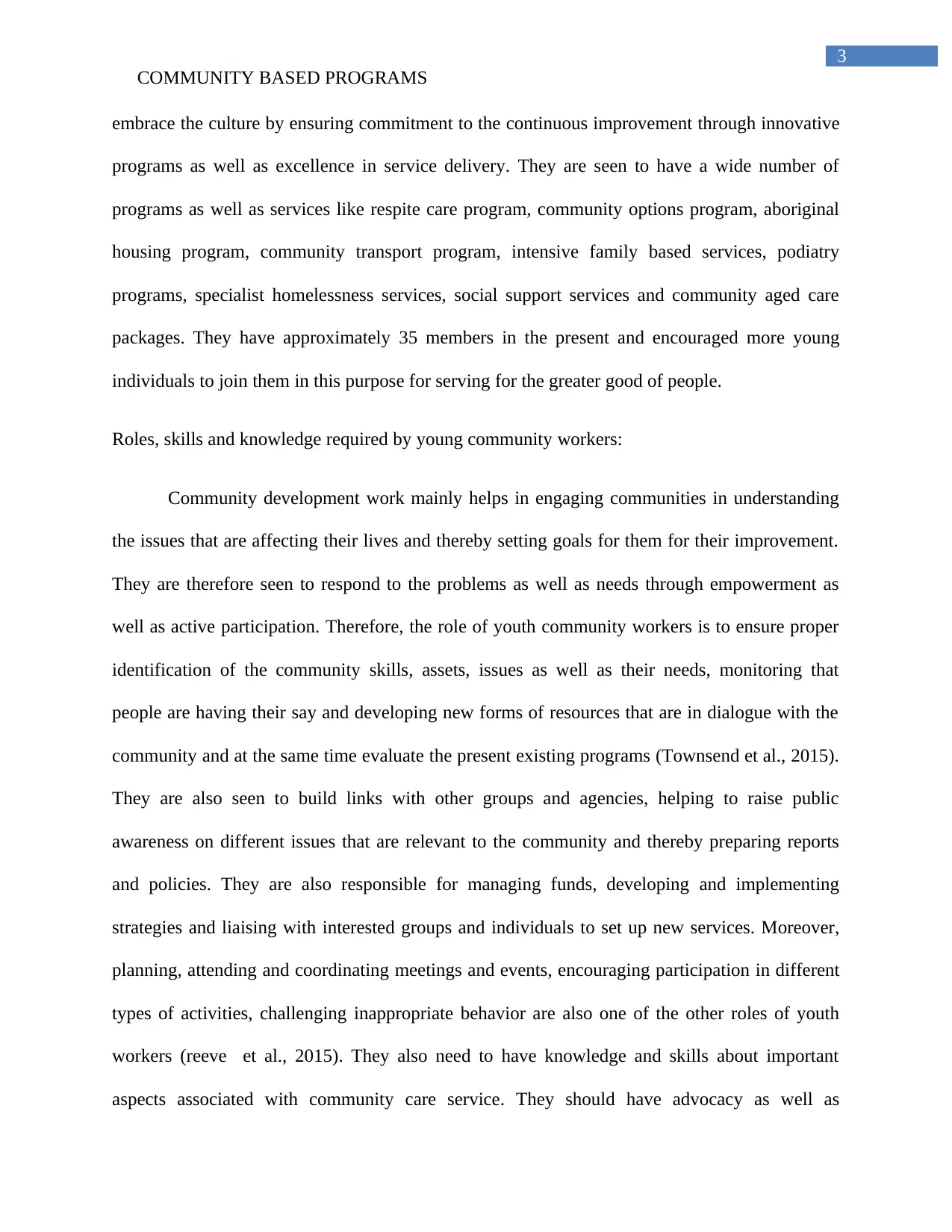
3
COMMUNITY BASED PROGRAMS
embrace the culture by ensuring commitment to the continuous improvement through innovative
programs as well as excellence in service delivery. They are seen to have a wide number of
programs as well as services like respite care program, community options program, aboriginal
housing program, community transport program, intensive family based services, podiatry
programs, specialist homelessness services, social support services and community aged care
packages. They have approximately 35 members in the present and encouraged more young
individuals to join them in this purpose for serving for the greater good of people.
Roles, skills and knowledge required by young community workers:
Community development work mainly helps in engaging communities in understanding
the issues that are affecting their lives and thereby setting goals for them for their improvement.
They are therefore seen to respond to the problems as well as needs through empowerment as
well as active participation. Therefore, the role of youth community workers is to ensure proper
identification of the community skills, assets, issues as well as their needs, monitoring that
people are having their say and developing new forms of resources that are in dialogue with the
community and at the same time evaluate the present existing programs (Townsend et al., 2015).
They are also seen to build links with other groups and agencies, helping to raise public
awareness on different issues that are relevant to the community and thereby preparing reports
and policies. They are also responsible for managing funds, developing and implementing
strategies and liaising with interested groups and individuals to set up new services. Moreover,
planning, attending and coordinating meetings and events, encouraging participation in different
types of activities, challenging inappropriate behavior are also one of the other roles of youth
workers (reeve et al., 2015). They also need to have knowledge and skills about important
aspects associated with community care service. They should have advocacy as well as
COMMUNITY BASED PROGRAMS
embrace the culture by ensuring commitment to the continuous improvement through innovative
programs as well as excellence in service delivery. They are seen to have a wide number of
programs as well as services like respite care program, community options program, aboriginal
housing program, community transport program, intensive family based services, podiatry
programs, specialist homelessness services, social support services and community aged care
packages. They have approximately 35 members in the present and encouraged more young
individuals to join them in this purpose for serving for the greater good of people.
Roles, skills and knowledge required by young community workers:
Community development work mainly helps in engaging communities in understanding
the issues that are affecting their lives and thereby setting goals for them for their improvement.
They are therefore seen to respond to the problems as well as needs through empowerment as
well as active participation. Therefore, the role of youth community workers is to ensure proper
identification of the community skills, assets, issues as well as their needs, monitoring that
people are having their say and developing new forms of resources that are in dialogue with the
community and at the same time evaluate the present existing programs (Townsend et al., 2015).
They are also seen to build links with other groups and agencies, helping to raise public
awareness on different issues that are relevant to the community and thereby preparing reports
and policies. They are also responsible for managing funds, developing and implementing
strategies and liaising with interested groups and individuals to set up new services. Moreover,
planning, attending and coordinating meetings and events, encouraging participation in different
types of activities, challenging inappropriate behavior are also one of the other roles of youth
workers (reeve et al., 2015). They also need to have knowledge and skills about important
aspects associated with community care service. They should have advocacy as well as
Paraphrase This Document
Need a fresh take? Get an instant paraphrase of this document with our AI Paraphraser
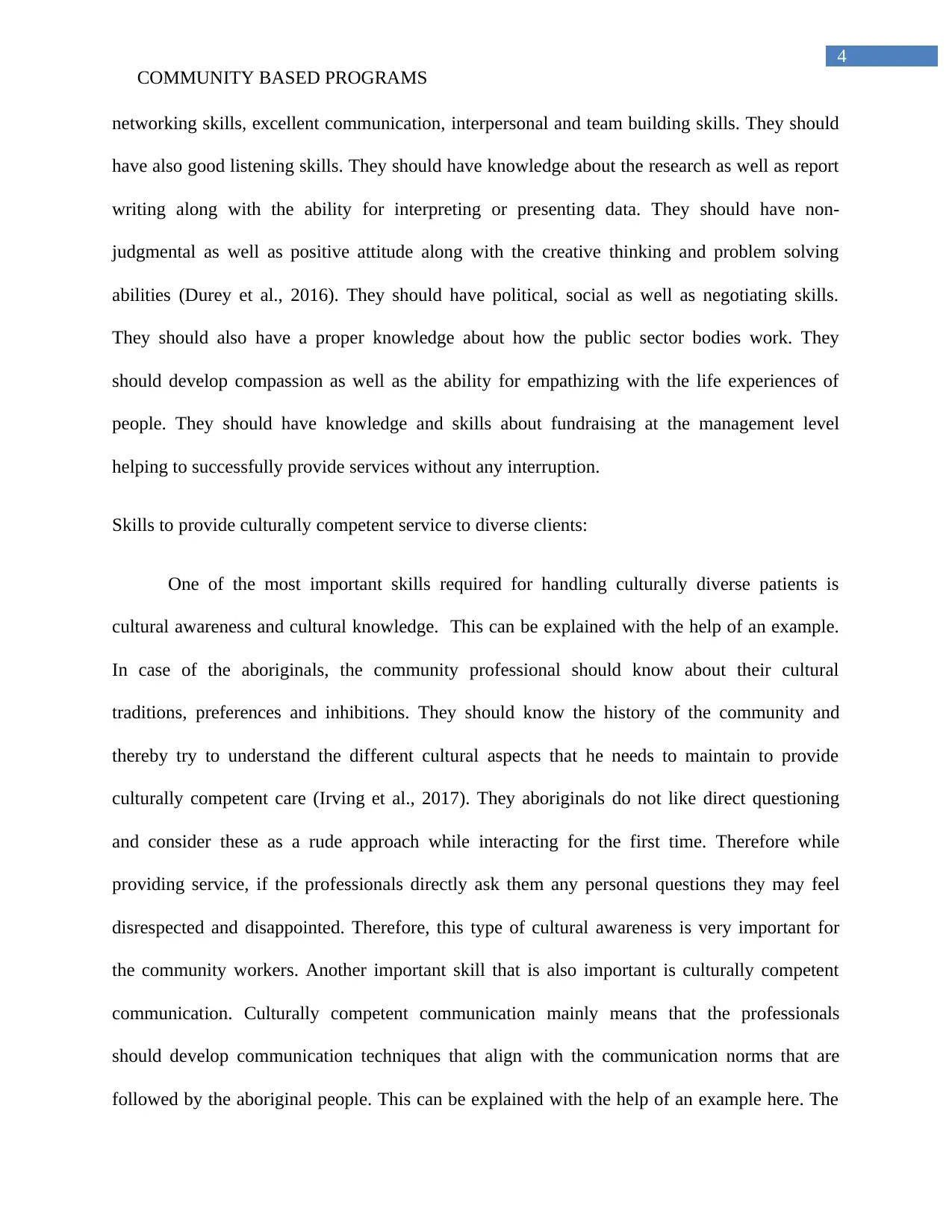
4
COMMUNITY BASED PROGRAMS
networking skills, excellent communication, interpersonal and team building skills. They should
have also good listening skills. They should have knowledge about the research as well as report
writing along with the ability for interpreting or presenting data. They should have non-
judgmental as well as positive attitude along with the creative thinking and problem solving
abilities (Durey et al., 2016). They should have political, social as well as negotiating skills.
They should also have a proper knowledge about how the public sector bodies work. They
should develop compassion as well as the ability for empathizing with the life experiences of
people. They should have knowledge and skills about fundraising at the management level
helping to successfully provide services without any interruption.
Skills to provide culturally competent service to diverse clients:
One of the most important skills required for handling culturally diverse patients is
cultural awareness and cultural knowledge. This can be explained with the help of an example.
In case of the aboriginals, the community professional should know about their cultural
traditions, preferences and inhibitions. They should know the history of the community and
thereby try to understand the different cultural aspects that he needs to maintain to provide
culturally competent care (Irving et al., 2017). They aboriginals do not like direct questioning
and consider these as a rude approach while interacting for the first time. Therefore while
providing service, if the professionals directly ask them any personal questions they may feel
disrespected and disappointed. Therefore, this type of cultural awareness is very important for
the community workers. Another important skill that is also important is culturally competent
communication. Culturally competent communication mainly means that the professionals
should develop communication techniques that align with the communication norms that are
followed by the aboriginal people. This can be explained with the help of an example here. The
COMMUNITY BASED PROGRAMS
networking skills, excellent communication, interpersonal and team building skills. They should
have also good listening skills. They should have knowledge about the research as well as report
writing along with the ability for interpreting or presenting data. They should have non-
judgmental as well as positive attitude along with the creative thinking and problem solving
abilities (Durey et al., 2016). They should have political, social as well as negotiating skills.
They should also have a proper knowledge about how the public sector bodies work. They
should develop compassion as well as the ability for empathizing with the life experiences of
people. They should have knowledge and skills about fundraising at the management level
helping to successfully provide services without any interruption.
Skills to provide culturally competent service to diverse clients:
One of the most important skills required for handling culturally diverse patients is
cultural awareness and cultural knowledge. This can be explained with the help of an example.
In case of the aboriginals, the community professional should know about their cultural
traditions, preferences and inhibitions. They should know the history of the community and
thereby try to understand the different cultural aspects that he needs to maintain to provide
culturally competent care (Irving et al., 2017). They aboriginals do not like direct questioning
and consider these as a rude approach while interacting for the first time. Therefore while
providing service, if the professionals directly ask them any personal questions they may feel
disrespected and disappointed. Therefore, this type of cultural awareness is very important for
the community workers. Another important skill that is also important is culturally competent
communication. Culturally competent communication mainly means that the professionals
should develop communication techniques that align with the communication norms that are
followed by the aboriginal people. This can be explained with the help of an example here. The
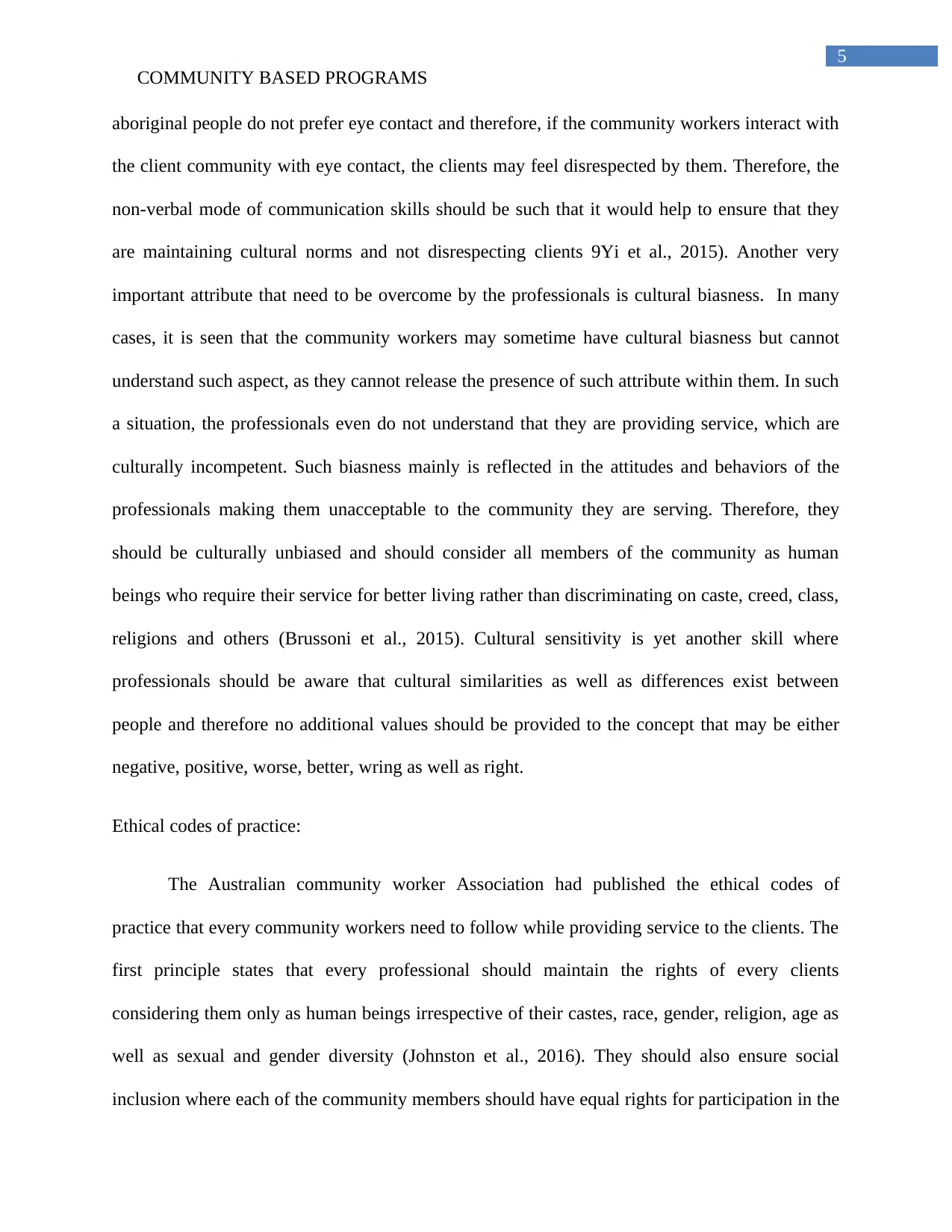
5
COMMUNITY BASED PROGRAMS
aboriginal people do not prefer eye contact and therefore, if the community workers interact with
the client community with eye contact, the clients may feel disrespected by them. Therefore, the
non-verbal mode of communication skills should be such that it would help to ensure that they
are maintaining cultural norms and not disrespecting clients 9Yi et al., 2015). Another very
important attribute that need to be overcome by the professionals is cultural biasness. In many
cases, it is seen that the community workers may sometime have cultural biasness but cannot
understand such aspect, as they cannot release the presence of such attribute within them. In such
a situation, the professionals even do not understand that they are providing service, which are
culturally incompetent. Such biasness mainly is reflected in the attitudes and behaviors of the
professionals making them unacceptable to the community they are serving. Therefore, they
should be culturally unbiased and should consider all members of the community as human
beings who require their service for better living rather than discriminating on caste, creed, class,
religions and others (Brussoni et al., 2015). Cultural sensitivity is yet another skill where
professionals should be aware that cultural similarities as well as differences exist between
people and therefore no additional values should be provided to the concept that may be either
negative, positive, worse, better, wring as well as right.
Ethical codes of practice:
The Australian community worker Association had published the ethical codes of
practice that every community workers need to follow while providing service to the clients. The
first principle states that every professional should maintain the rights of every clients
considering them only as human beings irrespective of their castes, race, gender, religion, age as
well as sexual and gender diversity (Johnston et al., 2016). They should also ensure social
inclusion where each of the community members should have equal rights for participation in the
COMMUNITY BASED PROGRAMS
aboriginal people do not prefer eye contact and therefore, if the community workers interact with
the client community with eye contact, the clients may feel disrespected by them. Therefore, the
non-verbal mode of communication skills should be such that it would help to ensure that they
are maintaining cultural norms and not disrespecting clients 9Yi et al., 2015). Another very
important attribute that need to be overcome by the professionals is cultural biasness. In many
cases, it is seen that the community workers may sometime have cultural biasness but cannot
understand such aspect, as they cannot release the presence of such attribute within them. In such
a situation, the professionals even do not understand that they are providing service, which are
culturally incompetent. Such biasness mainly is reflected in the attitudes and behaviors of the
professionals making them unacceptable to the community they are serving. Therefore, they
should be culturally unbiased and should consider all members of the community as human
beings who require their service for better living rather than discriminating on caste, creed, class,
religions and others (Brussoni et al., 2015). Cultural sensitivity is yet another skill where
professionals should be aware that cultural similarities as well as differences exist between
people and therefore no additional values should be provided to the concept that may be either
negative, positive, worse, better, wring as well as right.
Ethical codes of practice:
The Australian community worker Association had published the ethical codes of
practice that every community workers need to follow while providing service to the clients. The
first principle states that every professional should maintain the rights of every clients
considering them only as human beings irrespective of their castes, race, gender, religion, age as
well as sexual and gender diversity (Johnston et al., 2016). They should also ensure social
inclusion where each of the community members should have equal rights for participation in the
⊘ This is a preview!⊘
Do you want full access?
Subscribe today to unlock all pages.

Trusted by 1+ million students worldwide
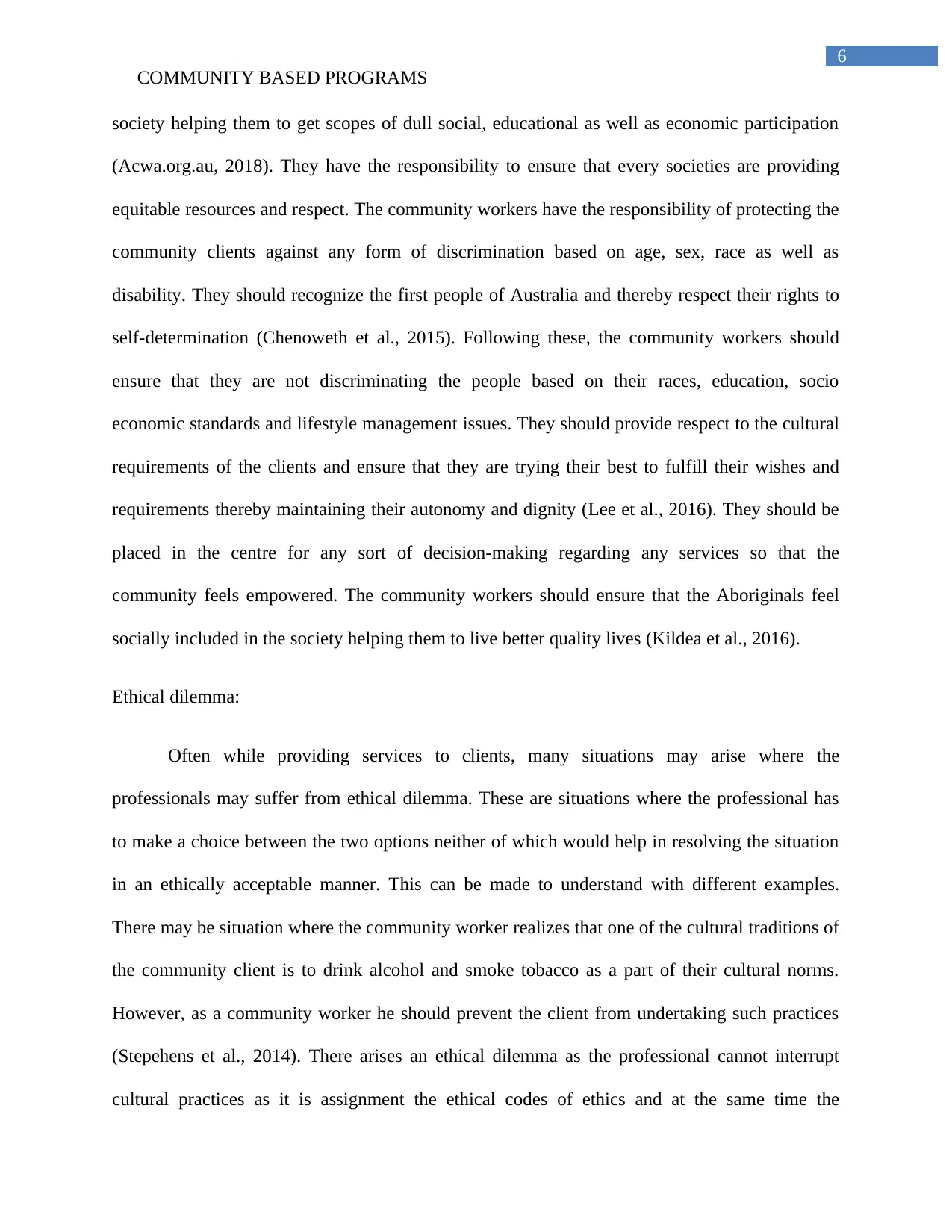
6
COMMUNITY BASED PROGRAMS
society helping them to get scopes of dull social, educational as well as economic participation
(Acwa.org.au, 2018). They have the responsibility to ensure that every societies are providing
equitable resources and respect. The community workers have the responsibility of protecting the
community clients against any form of discrimination based on age, sex, race as well as
disability. They should recognize the first people of Australia and thereby respect their rights to
self-determination (Chenoweth et al., 2015). Following these, the community workers should
ensure that they are not discriminating the people based on their races, education, socio
economic standards and lifestyle management issues. They should provide respect to the cultural
requirements of the clients and ensure that they are trying their best to fulfill their wishes and
requirements thereby maintaining their autonomy and dignity (Lee et al., 2016). They should be
placed in the centre for any sort of decision-making regarding any services so that the
community feels empowered. The community workers should ensure that the Aboriginals feel
socially included in the society helping them to live better quality lives (Kildea et al., 2016).
Ethical dilemma:
Often while providing services to clients, many situations may arise where the
professionals may suffer from ethical dilemma. These are situations where the professional has
to make a choice between the two options neither of which would help in resolving the situation
in an ethically acceptable manner. This can be made to understand with different examples.
There may be situation where the community worker realizes that one of the cultural traditions of
the community client is to drink alcohol and smoke tobacco as a part of their cultural norms.
However, as a community worker he should prevent the client from undertaking such practices
(Stepehens et al., 2014). There arises an ethical dilemma as the professional cannot interrupt
cultural practices as it is assignment the ethical codes of ethics and at the same time the
COMMUNITY BASED PROGRAMS
society helping them to get scopes of dull social, educational as well as economic participation
(Acwa.org.au, 2018). They have the responsibility to ensure that every societies are providing
equitable resources and respect. The community workers have the responsibility of protecting the
community clients against any form of discrimination based on age, sex, race as well as
disability. They should recognize the first people of Australia and thereby respect their rights to
self-determination (Chenoweth et al., 2015). Following these, the community workers should
ensure that they are not discriminating the people based on their races, education, socio
economic standards and lifestyle management issues. They should provide respect to the cultural
requirements of the clients and ensure that they are trying their best to fulfill their wishes and
requirements thereby maintaining their autonomy and dignity (Lee et al., 2016). They should be
placed in the centre for any sort of decision-making regarding any services so that the
community feels empowered. The community workers should ensure that the Aboriginals feel
socially included in the society helping them to live better quality lives (Kildea et al., 2016).
Ethical dilemma:
Often while providing services to clients, many situations may arise where the
professionals may suffer from ethical dilemma. These are situations where the professional has
to make a choice between the two options neither of which would help in resolving the situation
in an ethically acceptable manner. This can be made to understand with different examples.
There may be situation where the community worker realizes that one of the cultural traditions of
the community client is to drink alcohol and smoke tobacco as a part of their cultural norms.
However, as a community worker he should prevent the client from undertaking such practices
(Stepehens et al., 2014). There arises an ethical dilemma as the professional cannot interrupt
cultural practices as it is assignment the ethical codes of ethics and at the same time the
Paraphrase This Document
Need a fresh take? Get an instant paraphrase of this document with our AI Paraphraser
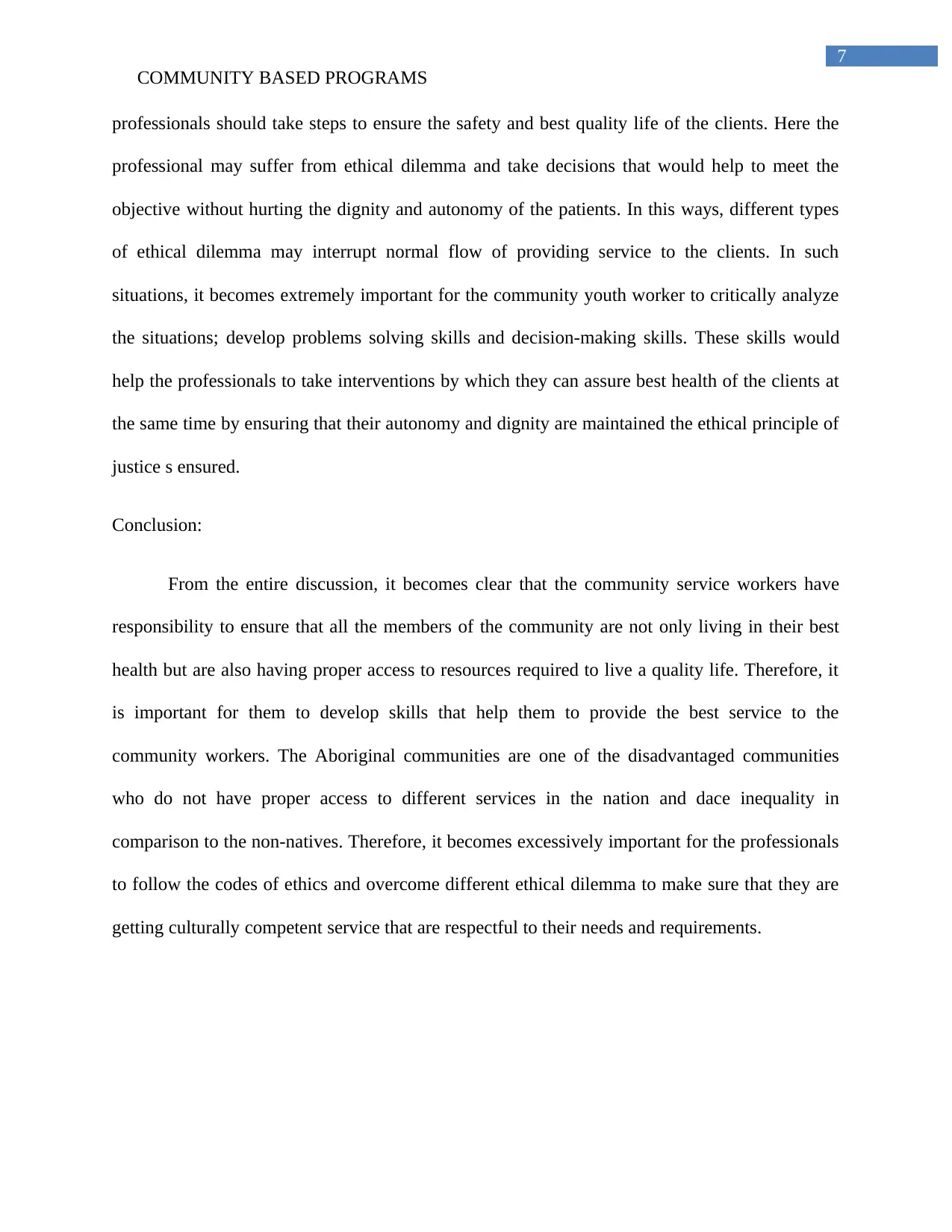
7
COMMUNITY BASED PROGRAMS
professionals should take steps to ensure the safety and best quality life of the clients. Here the
professional may suffer from ethical dilemma and take decisions that would help to meet the
objective without hurting the dignity and autonomy of the patients. In this ways, different types
of ethical dilemma may interrupt normal flow of providing service to the clients. In such
situations, it becomes extremely important for the community youth worker to critically analyze
the situations; develop problems solving skills and decision-making skills. These skills would
help the professionals to take interventions by which they can assure best health of the clients at
the same time by ensuring that their autonomy and dignity are maintained the ethical principle of
justice s ensured.
Conclusion:
From the entire discussion, it becomes clear that the community service workers have
responsibility to ensure that all the members of the community are not only living in their best
health but are also having proper access to resources required to live a quality life. Therefore, it
is important for them to develop skills that help them to provide the best service to the
community workers. The Aboriginal communities are one of the disadvantaged communities
who do not have proper access to different services in the nation and dace inequality in
comparison to the non-natives. Therefore, it becomes excessively important for the professionals
to follow the codes of ethics and overcome different ethical dilemma to make sure that they are
getting culturally competent service that are respectful to their needs and requirements.
COMMUNITY BASED PROGRAMS
professionals should take steps to ensure the safety and best quality life of the clients. Here the
professional may suffer from ethical dilemma and take decisions that would help to meet the
objective without hurting the dignity and autonomy of the patients. In this ways, different types
of ethical dilemma may interrupt normal flow of providing service to the clients. In such
situations, it becomes extremely important for the community youth worker to critically analyze
the situations; develop problems solving skills and decision-making skills. These skills would
help the professionals to take interventions by which they can assure best health of the clients at
the same time by ensuring that their autonomy and dignity are maintained the ethical principle of
justice s ensured.
Conclusion:
From the entire discussion, it becomes clear that the community service workers have
responsibility to ensure that all the members of the community are not only living in their best
health but are also having proper access to resources required to live a quality life. Therefore, it
is important for them to develop skills that help them to provide the best service to the
community workers. The Aboriginal communities are one of the disadvantaged communities
who do not have proper access to different services in the nation and dace inequality in
comparison to the non-natives. Therefore, it becomes excessively important for the professionals
to follow the codes of ethics and overcome different ethical dilemma to make sure that they are
getting culturally competent service that are respectful to their needs and requirements.
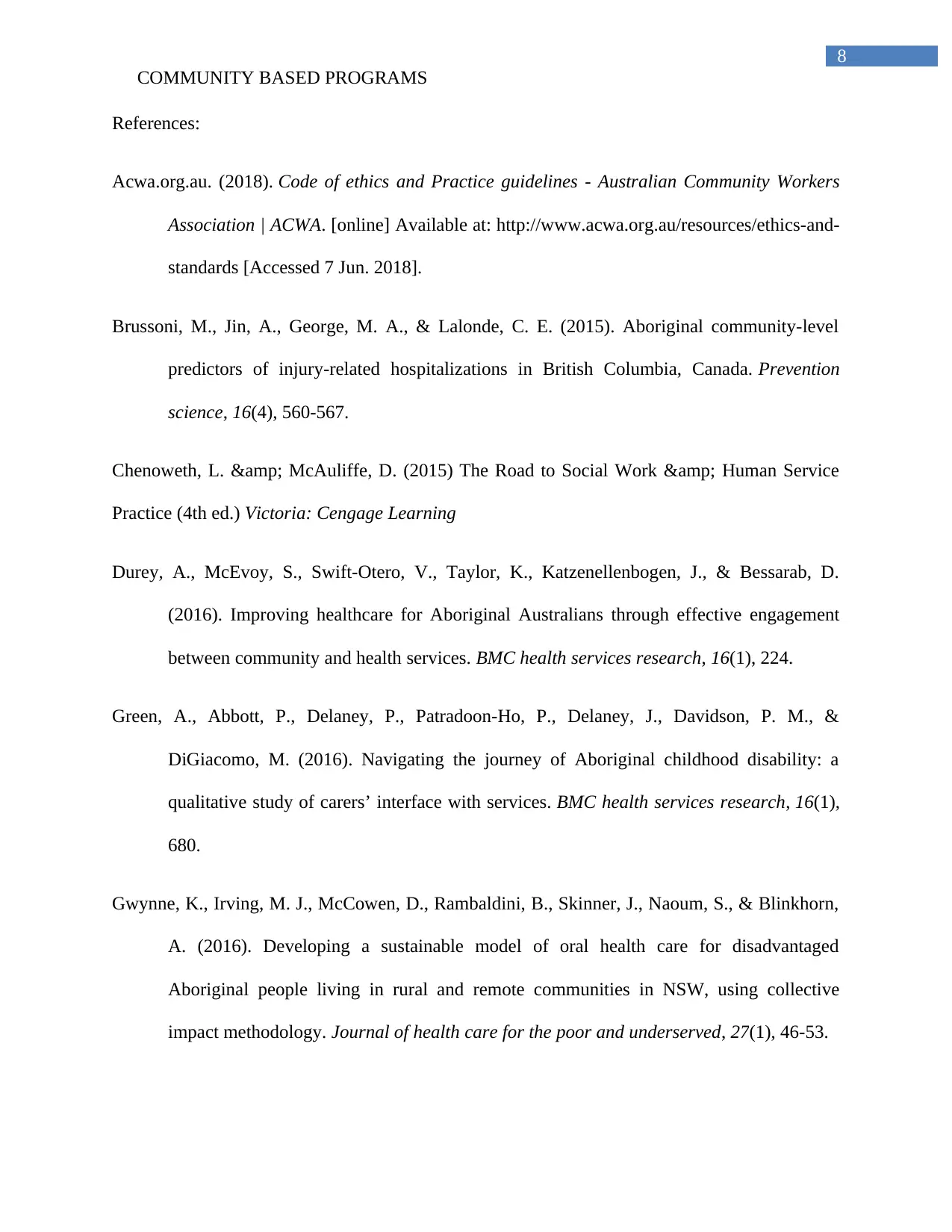
8
COMMUNITY BASED PROGRAMS
References:
Acwa.org.au. (2018). Code of ethics and Practice guidelines - Australian Community Workers
Association | ACWA. [online] Available at: http://www.acwa.org.au/resources/ethics-and-
standards [Accessed 7 Jun. 2018].
Brussoni, M., Jin, A., George, M. A., & Lalonde, C. E. (2015). Aboriginal community-level
predictors of injury-related hospitalizations in British Columbia, Canada. Prevention
science, 16(4), 560-567.
Chenoweth, L. & McAuliffe, D. (2015) The Road to Social Work & Human Service
Practice (4th ed.) Victoria: Cengage Learning
Durey, A., McEvoy, S., Swift-Otero, V., Taylor, K., Katzenellenbogen, J., & Bessarab, D.
(2016). Improving healthcare for Aboriginal Australians through effective engagement
between community and health services. BMC health services research, 16(1), 224.
Green, A., Abbott, P., Delaney, P., Patradoon-Ho, P., Delaney, J., Davidson, P. M., &
DiGiacomo, M. (2016). Navigating the journey of Aboriginal childhood disability: a
qualitative study of carers’ interface with services. BMC health services research, 16(1),
680.
Gwynne, K., Irving, M. J., McCowen, D., Rambaldini, B., Skinner, J., Naoum, S., & Blinkhorn,
A. (2016). Developing a sustainable model of oral health care for disadvantaged
Aboriginal people living in rural and remote communities in NSW, using collective
impact methodology. Journal of health care for the poor and underserved, 27(1), 46-53.
COMMUNITY BASED PROGRAMS
References:
Acwa.org.au. (2018). Code of ethics and Practice guidelines - Australian Community Workers
Association | ACWA. [online] Available at: http://www.acwa.org.au/resources/ethics-and-
standards [Accessed 7 Jun. 2018].
Brussoni, M., Jin, A., George, M. A., & Lalonde, C. E. (2015). Aboriginal community-level
predictors of injury-related hospitalizations in British Columbia, Canada. Prevention
science, 16(4), 560-567.
Chenoweth, L. & McAuliffe, D. (2015) The Road to Social Work & Human Service
Practice (4th ed.) Victoria: Cengage Learning
Durey, A., McEvoy, S., Swift-Otero, V., Taylor, K., Katzenellenbogen, J., & Bessarab, D.
(2016). Improving healthcare for Aboriginal Australians through effective engagement
between community and health services. BMC health services research, 16(1), 224.
Green, A., Abbott, P., Delaney, P., Patradoon-Ho, P., Delaney, J., Davidson, P. M., &
DiGiacomo, M. (2016). Navigating the journey of Aboriginal childhood disability: a
qualitative study of carers’ interface with services. BMC health services research, 16(1),
680.
Gwynne, K., Irving, M. J., McCowen, D., Rambaldini, B., Skinner, J., Naoum, S., & Blinkhorn,
A. (2016). Developing a sustainable model of oral health care for disadvantaged
Aboriginal people living in rural and remote communities in NSW, using collective
impact methodology. Journal of health care for the poor and underserved, 27(1), 46-53.
⊘ This is a preview!⊘
Do you want full access?
Subscribe today to unlock all pages.

Trusted by 1+ million students worldwide
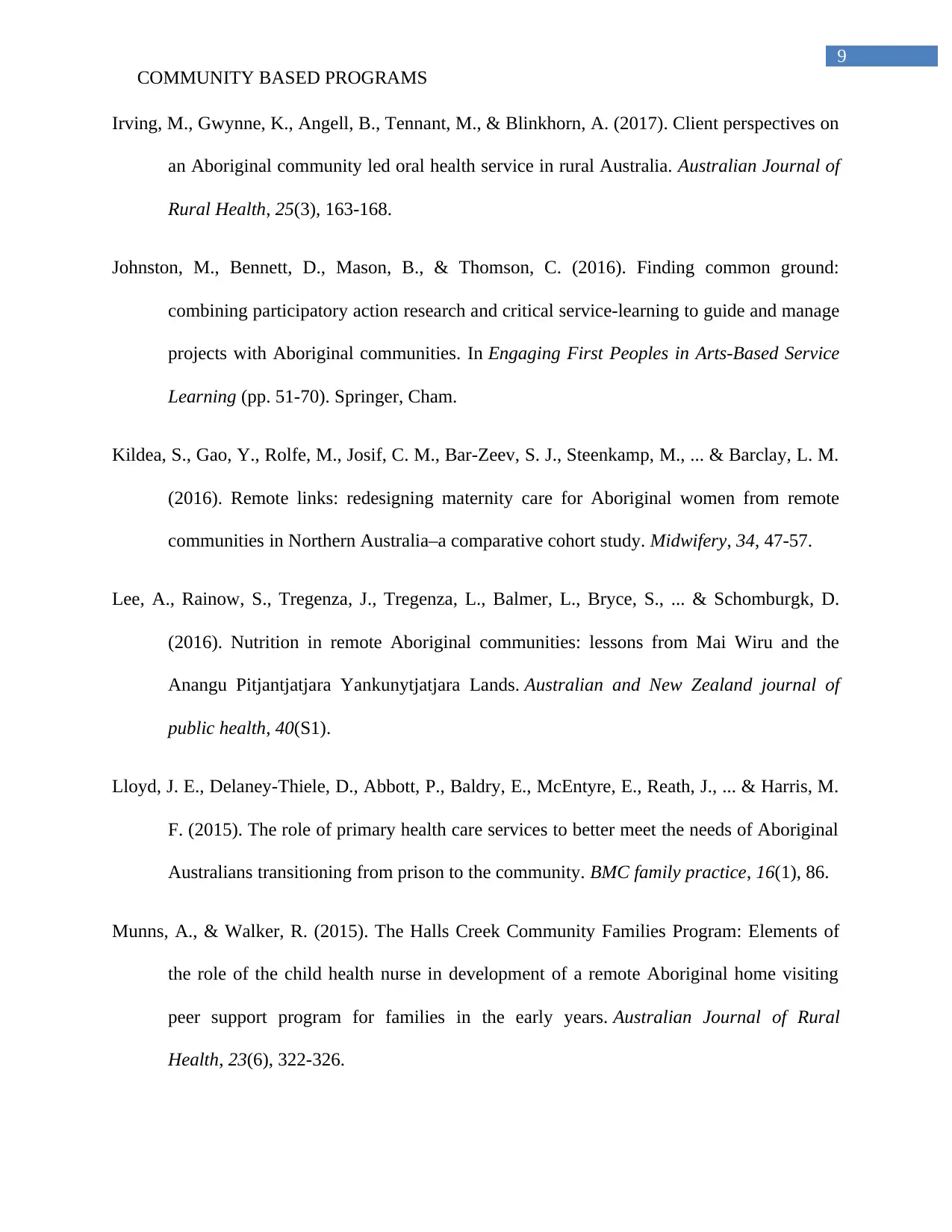
9
COMMUNITY BASED PROGRAMS
Irving, M., Gwynne, K., Angell, B., Tennant, M., & Blinkhorn, A. (2017). Client perspectives on
an Aboriginal community led oral health service in rural Australia. Australian Journal of
Rural Health, 25(3), 163-168.
Johnston, M., Bennett, D., Mason, B., & Thomson, C. (2016). Finding common ground:
combining participatory action research and critical service-learning to guide and manage
projects with Aboriginal communities. In Engaging First Peoples in Arts-Based Service
Learning (pp. 51-70). Springer, Cham.
Kildea, S., Gao, Y., Rolfe, M., Josif, C. M., Bar-Zeev, S. J., Steenkamp, M., ... & Barclay, L. M.
(2016). Remote links: redesigning maternity care for Aboriginal women from remote
communities in Northern Australia–a comparative cohort study. Midwifery, 34, 47-57.
Lee, A., Rainow, S., Tregenza, J., Tregenza, L., Balmer, L., Bryce, S., ... & Schomburgk, D.
(2016). Nutrition in remote Aboriginal communities: lessons from Mai Wiru and the
Anangu Pitjantjatjara Yankunytjatjara Lands. Australian and New Zealand journal of
public health, 40(S1).
Lloyd, J. E., Delaney-Thiele, D., Abbott, P., Baldry, E., McEntyre, E., Reath, J., ... & Harris, M.
F. (2015). The role of primary health care services to better meet the needs of Aboriginal
Australians transitioning from prison to the community. BMC family practice, 16(1), 86.
Munns, A., & Walker, R. (2015). The Halls Creek Community Families Program: Elements of
the role of the child health nurse in development of a remote Aboriginal home visiting
peer support program for families in the early years. Australian Journal of Rural
Health, 23(6), 322-326.
COMMUNITY BASED PROGRAMS
Irving, M., Gwynne, K., Angell, B., Tennant, M., & Blinkhorn, A. (2017). Client perspectives on
an Aboriginal community led oral health service in rural Australia. Australian Journal of
Rural Health, 25(3), 163-168.
Johnston, M., Bennett, D., Mason, B., & Thomson, C. (2016). Finding common ground:
combining participatory action research and critical service-learning to guide and manage
projects with Aboriginal communities. In Engaging First Peoples in Arts-Based Service
Learning (pp. 51-70). Springer, Cham.
Kildea, S., Gao, Y., Rolfe, M., Josif, C. M., Bar-Zeev, S. J., Steenkamp, M., ... & Barclay, L. M.
(2016). Remote links: redesigning maternity care for Aboriginal women from remote
communities in Northern Australia–a comparative cohort study. Midwifery, 34, 47-57.
Lee, A., Rainow, S., Tregenza, J., Tregenza, L., Balmer, L., Bryce, S., ... & Schomburgk, D.
(2016). Nutrition in remote Aboriginal communities: lessons from Mai Wiru and the
Anangu Pitjantjatjara Yankunytjatjara Lands. Australian and New Zealand journal of
public health, 40(S1).
Lloyd, J. E., Delaney-Thiele, D., Abbott, P., Baldry, E., McEntyre, E., Reath, J., ... & Harris, M.
F. (2015). The role of primary health care services to better meet the needs of Aboriginal
Australians transitioning from prison to the community. BMC family practice, 16(1), 86.
Munns, A., & Walker, R. (2015). The Halls Creek Community Families Program: Elements of
the role of the child health nurse in development of a remote Aboriginal home visiting
peer support program for families in the early years. Australian Journal of Rural
Health, 23(6), 322-326.
Paraphrase This Document
Need a fresh take? Get an instant paraphrase of this document with our AI Paraphraser
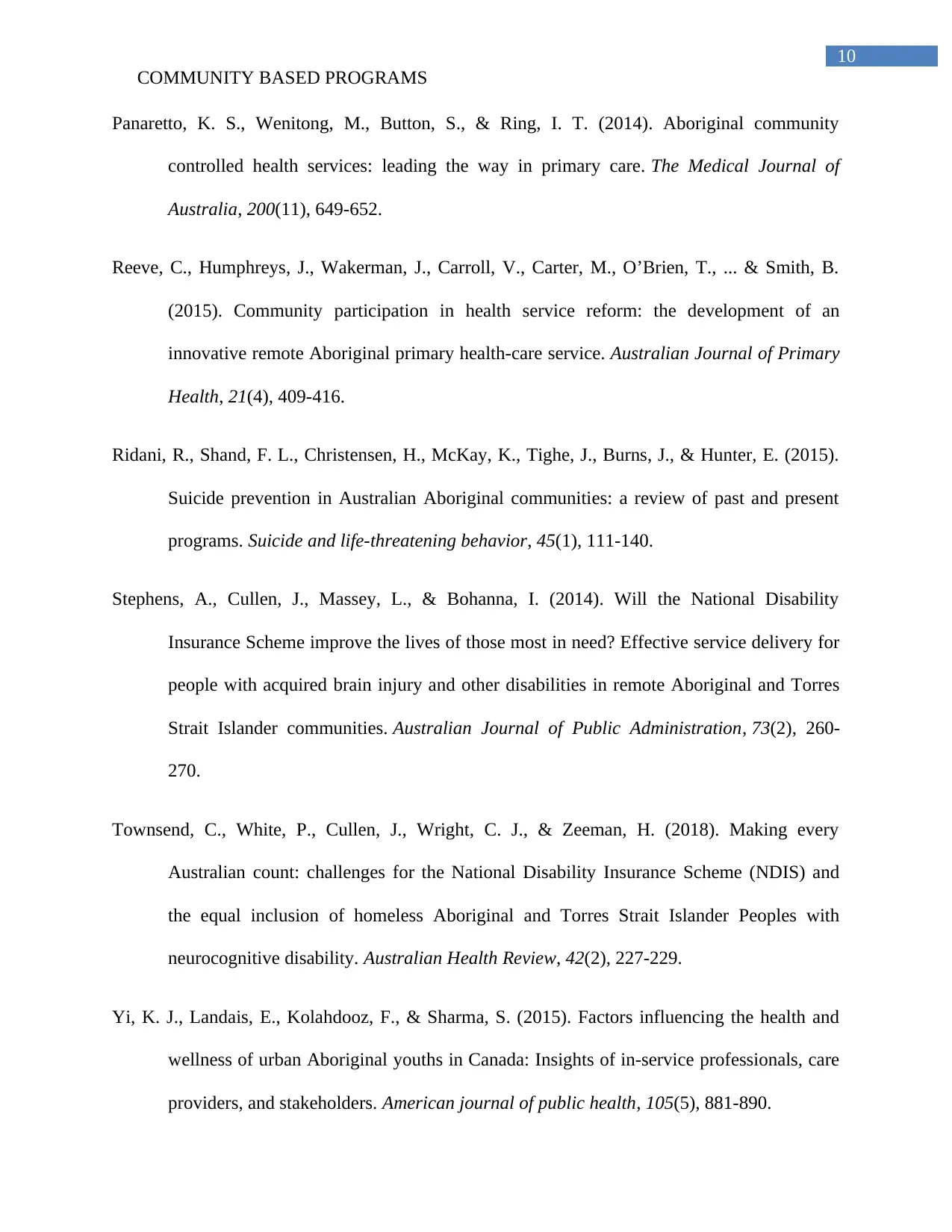
10
COMMUNITY BASED PROGRAMS
Panaretto, K. S., Wenitong, M., Button, S., & Ring, I. T. (2014). Aboriginal community
controlled health services: leading the way in primary care. The Medical Journal of
Australia, 200(11), 649-652.
Reeve, C., Humphreys, J., Wakerman, J., Carroll, V., Carter, M., O’Brien, T., ... & Smith, B.
(2015). Community participation in health service reform: the development of an
innovative remote Aboriginal primary health-care service. Australian Journal of Primary
Health, 21(4), 409-416.
Ridani, R., Shand, F. L., Christensen, H., McKay, K., Tighe, J., Burns, J., & Hunter, E. (2015).
Suicide prevention in Australian Aboriginal communities: a review of past and present
programs. Suicide and life-threatening behavior, 45(1), 111-140.
Stephens, A., Cullen, J., Massey, L., & Bohanna, I. (2014). Will the National Disability
Insurance Scheme improve the lives of those most in need? Effective service delivery for
people with acquired brain injury and other disabilities in remote Aboriginal and Torres
Strait Islander communities. Australian Journal of Public Administration, 73(2), 260-
270.
Townsend, C., White, P., Cullen, J., Wright, C. J., & Zeeman, H. (2018). Making every
Australian count: challenges for the National Disability Insurance Scheme (NDIS) and
the equal inclusion of homeless Aboriginal and Torres Strait Islander Peoples with
neurocognitive disability. Australian Health Review, 42(2), 227-229.
Yi, K. J., Landais, E., Kolahdooz, F., & Sharma, S. (2015). Factors influencing the health and
wellness of urban Aboriginal youths in Canada: Insights of in-service professionals, care
providers, and stakeholders. American journal of public health, 105(5), 881-890.
COMMUNITY BASED PROGRAMS
Panaretto, K. S., Wenitong, M., Button, S., & Ring, I. T. (2014). Aboriginal community
controlled health services: leading the way in primary care. The Medical Journal of
Australia, 200(11), 649-652.
Reeve, C., Humphreys, J., Wakerman, J., Carroll, V., Carter, M., O’Brien, T., ... & Smith, B.
(2015). Community participation in health service reform: the development of an
innovative remote Aboriginal primary health-care service. Australian Journal of Primary
Health, 21(4), 409-416.
Ridani, R., Shand, F. L., Christensen, H., McKay, K., Tighe, J., Burns, J., & Hunter, E. (2015).
Suicide prevention in Australian Aboriginal communities: a review of past and present
programs. Suicide and life-threatening behavior, 45(1), 111-140.
Stephens, A., Cullen, J., Massey, L., & Bohanna, I. (2014). Will the National Disability
Insurance Scheme improve the lives of those most in need? Effective service delivery for
people with acquired brain injury and other disabilities in remote Aboriginal and Torres
Strait Islander communities. Australian Journal of Public Administration, 73(2), 260-
270.
Townsend, C., White, P., Cullen, J., Wright, C. J., & Zeeman, H. (2018). Making every
Australian count: challenges for the National Disability Insurance Scheme (NDIS) and
the equal inclusion of homeless Aboriginal and Torres Strait Islander Peoples with
neurocognitive disability. Australian Health Review, 42(2), 227-229.
Yi, K. J., Landais, E., Kolahdooz, F., & Sharma, S. (2015). Factors influencing the health and
wellness of urban Aboriginal youths in Canada: Insights of in-service professionals, care
providers, and stakeholders. American journal of public health, 105(5), 881-890.
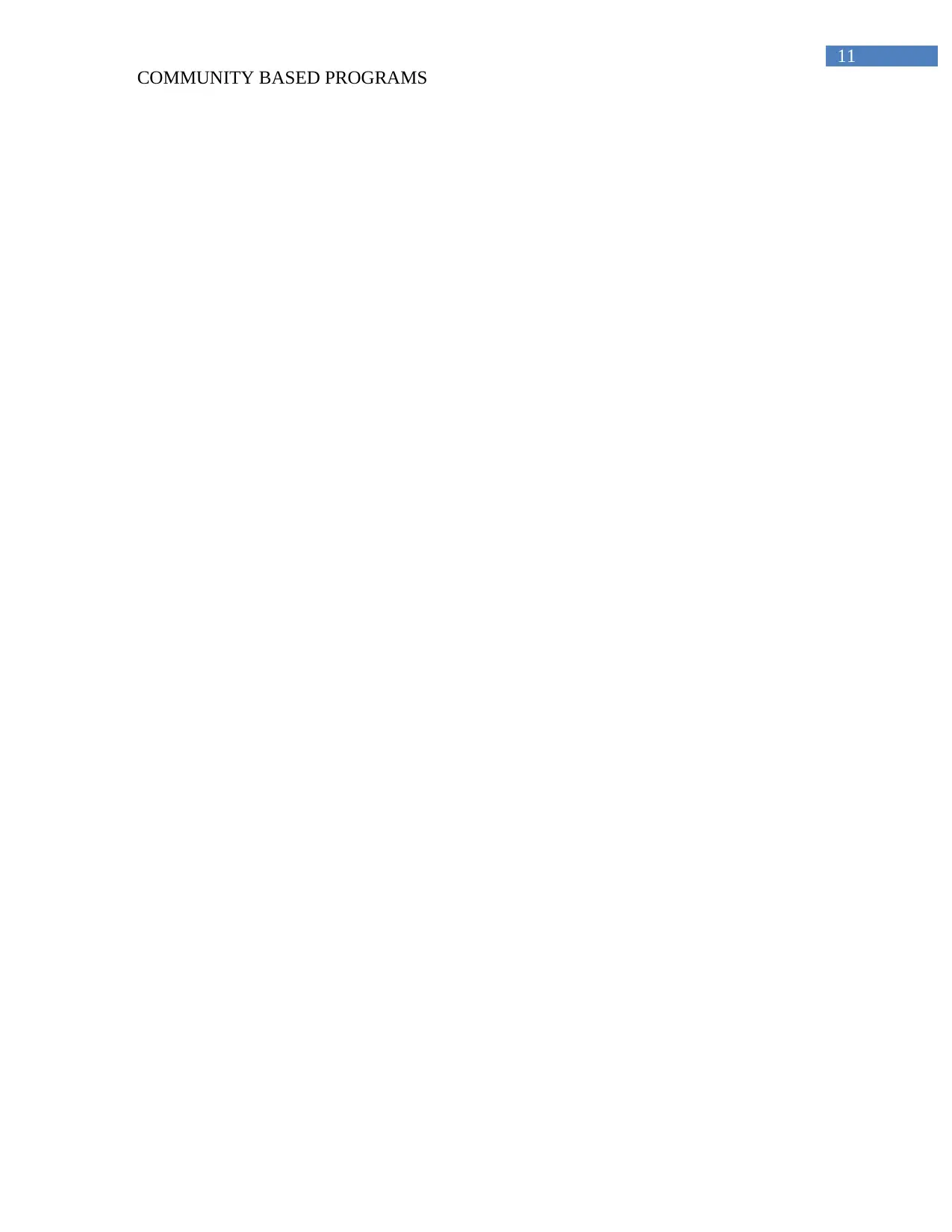
11
COMMUNITY BASED PROGRAMS
COMMUNITY BASED PROGRAMS
⊘ This is a preview!⊘
Do you want full access?
Subscribe today to unlock all pages.

Trusted by 1+ million students worldwide
1 out of 12
Related Documents
Your All-in-One AI-Powered Toolkit for Academic Success.
+13062052269
info@desklib.com
Available 24*7 on WhatsApp / Email
![[object Object]](/_next/static/media/star-bottom.7253800d.svg)
Unlock your academic potential
Copyright © 2020–2025 A2Z Services. All Rights Reserved. Developed and managed by ZUCOL.





